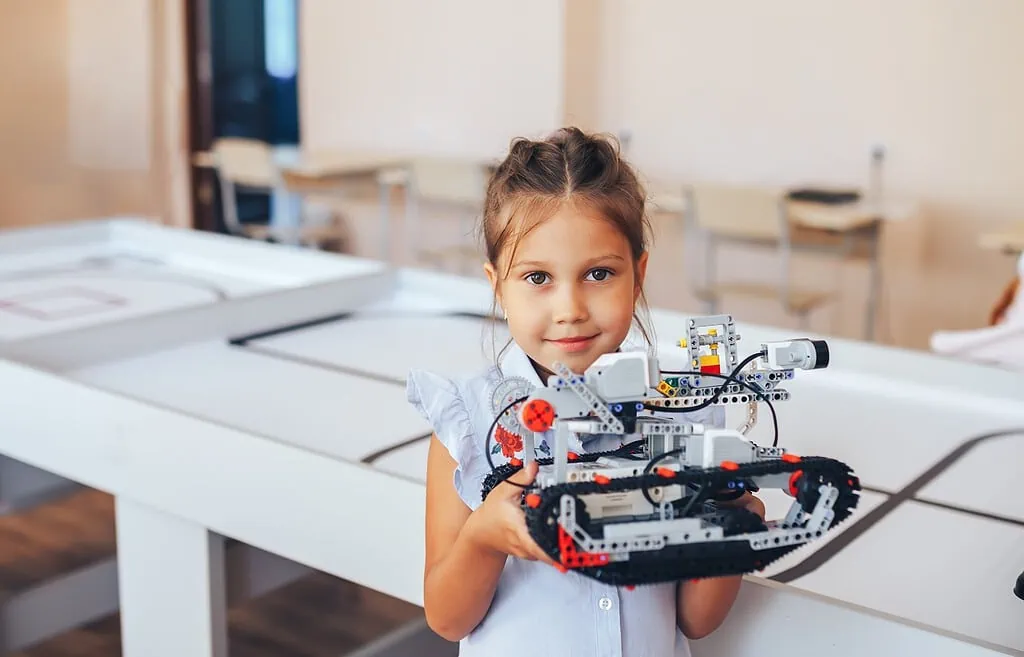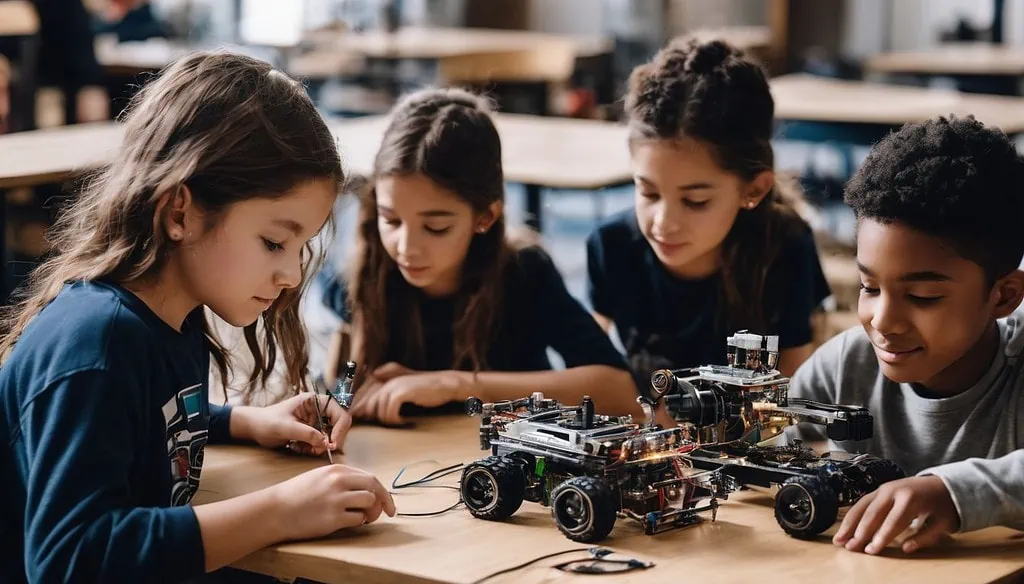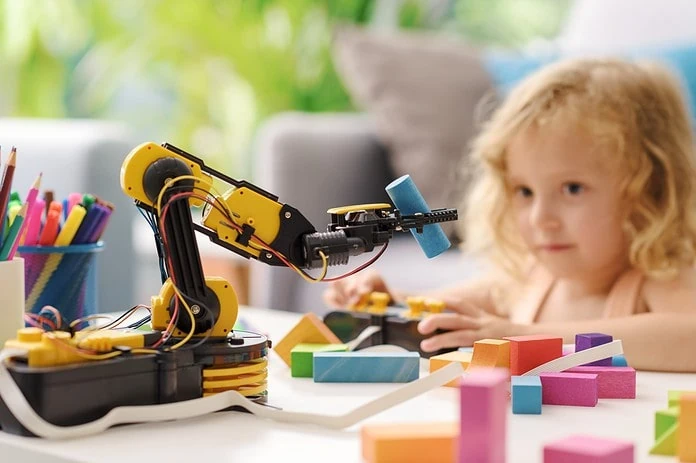Robotics for kids is an evolving educational avenue that not only introduces children to the fascinating world of robots but also hones essential skills such as critical thinking, creativity, teamwork, and problem-solving, preparing them for a technologically driven future. Here’s an astonishing fact — by 2025, we expect over 4 million robots to be zipping around in educational institutions globally!
We’ll break down everything you need to know – from its key role in spurring STEM learning to how it nourishes creativity and sharpens problem-solving skills. So, let’s start by asking, what is robotics for kids?
Summary
- Robotics for kids helps them learn about science and math by building robots.
- Learning robotics improves creativity, problem-solving, and teamwork skills.
- Kids can start learning robotics with kits or online classes.
- Getting into robotics early can help prepare for future tech jobs.
The Importance of Robotics for Kids
Engaging in robotics sharpens kids’ STEM (Science, Technology, Engineering, and Math) skills. It’s a hands-on way to develop their motor capabilities and computational thinking. Moreover, it fuels creativity as they devise solutions to problems.
Fosters STEM learning
Engaging with robotics holds a fascinating key to unlocking your kid’s potential in STEM education. Your child will get hands-on learning opportunities, sinking their teeth into real-world problems and providing crucial context for complex science, technology, engineering, and mathematics concepts.
Imagine your child coding and programming their robot to perform tasks! This is just one example of how they’ll harness the power of educational technology while developing critical thinking abilities.
It’s not all algorithms and circuit boards; there’s plenty of room for creativity and innovation too! Robotics infuses computational thinking with artistry as kids design functional and aesthetically pleasing robots.
The deep engagement encouraged by this field also ensures enthusiastic participation from kids in other STEAM activities, expanding their horizons beyond traditional classroom learning.
Develops motor skills
Manipulating robots in various activities refines children’s fine and gross motor skills. As they assemble parts, adjust angles, or mount wheels on their mechanical friends, kids inadvertently sharpen dexterity and physical coordination.
Skillsets like hand-eye coordination get significantly enhanced due to repeated tweaking and troubleshooting in robotics.
Moreover, these engaging activities substantially boost the spatial awareness of young learners. They begin understanding physics principles such as force, balance, and gravity through practical implementation while handling robotic kits.
Also noteworthy is the development of their manual skills that help them attain precise control over objects, contributing mainly to refining motor planning and execution abilities for life!
Builds computational skills
Exploration into the world of robotics pushes kids to develop a strong foundation in computational skills. Getting involved with coding and programming robots, children inevitably delve into algorithmic thinking.

This paves the way for sharpening their analytical reasoning, which is a highly desirable academic and professional skill. Mathematical reasoning becomes more intuitive as they decide how to program their robots to perform specific tasks.
Through this process, educational robots weave in cognitive development alongside computational learning. The beauty of Robotics lies in its hands-on approach, where problem-solving and critical thinking are encouraged at every stage, turning STEM education into an engaging pursuit rather than a challenging chore for your kids!
Encourages creativity and problem-solving
Robotics for kids ignites a spark of creativity, pushing them to think outside the box. The fun and excitement fueled by designing their robots are not just about assembling pieces.
It’s about employing innovation and ingenuity to create something unique. Kids enhance their engineering skills with every new robot they build and dive deep into scientific exploration.
Problem-solving is another vital skill that robotics cultivates in young learners. From learning how complex coding fits into technology to figuring out why a certain piece doesn’t work as it should, children continuously face challenges that require critical thinking abilities.
Each hurdle conquered boosts their confidence in tackling problems head-on – be it in academics or real-world situations! Through this hands-on approach of facing problems and devising creative solutions, we give our youngsters the tools to thrive in an ever-evolving technological world.
Learning Outcomes

Your child’s journey into robotics education starts with the basics of programming, leading to hands-on projects that ignite creativity and foster problem-solving. As they dive deeper, teamwork becomes essential – a life skill necessary for future tech-related jobs.
Introduction to programming and robotics
In robotics for kids, getting started with programming and building robots plays a pivotal role. Using fun and interactive robotics kits, youngsters delve into an immersive learning experience beyond traditional classroom teaching.
They grasp essential principles of coding, logical reasoning, and computational thinking while facing practical engineering design challenges.
These early introductions to programming mark the beginning of their journey into the world of tech-savvy innovation. Kids can explore hands-on learning activities by assembling mechanical parts and writing code instructions for their creations.
This cultivates a strong foundation in STEM education and equips them with problem-solving skills crucial for future industry demands.
Hands-on projects and problem-solving challenges
Robotics for kids provides a platform where creativity can thrive through hands-on projects and problem-solving challenges. It’s engaging and fun, making learning much more interactive. Here are some ways in which robotics accomplishes this:
- It offers opportunities for children to build their robots using various kits.
- Children learn to code and control these machines, an essential skill in today’s digital world.
- Kids experiment with different engineering concepts during the building process.
- Children can enhance their problem-solving abilities while troubleshooting errors or optimizing their robots’ performance.
- Incorporating robotics into interdisciplinary lessons makes complex subjects like science, math, English, and social studies more tangible and understandable.
- Robotics encourages teamwork as children work together in groups or pairs for collaborative learning and problem-solving.
- This collaboration aids them further by boosting their communication skills along with technical knowledge.
Teamwork and collaboration skills
Robotics maintains a remarkable emphasis on teamwork and collaboration skills. Many robotics activities involve group work, allowing kids to further learn the significance of cooperation.
It builds a sense of shared goals and encourages peer collaboration. The rich social learning environment offered by robotics classes fosters student communication, making it an excellent platform for developing efficient partnership skills.
Moreover, tackling problem-solving challenges together hones leadership abilities in kids while teaching them crucial conflict-resolution techniques. Thus, incorporating robotics into your child’s curriculum can significantly boost their interpersonal capabilities and prepare them for future collaborative endeavors.
Technological literacy
Understanding robotics can unlock a door to the future for your child. Technology isn’t slowing down; it’s rapidly advancing, and jobs in this field are booming. With the right guidance, kids who dive into robotics now will be ahead of their peers when it’s time to look at career development opportunities in technology-driven sectors.
Coding skills gained from learning robotics are not just about controlling robots but also imparting kids with the technological literacy needed for thriving in tomorrow’s job market. Learning to maneuver complex technological challenges through hands-on projects provides a practical link between engaging learning activities and core curriculum teachings.
Resources and Opportunities for Robotics Learning
There are various resources available to introduce kids to robotics. Robotics kits and platforms provide a hands-on learning experience where kids can build their robots. For virtual learning, online robotics classes offer interactive lessons guided by expert instructors.
To foster teamwork and peer learning, educational robotics clubs are excellent platforms for kids to engage in group projects and competitions. These resources provide numerous opportunities for children to explore the exciting world of robotics while equipping them with essential skills for the future.
Robotics kits and platforms for kids
Let’s delve into the world of robotics kits and platforms, an exciting resource for your children’s learning journey.
- Arduino Nano stands as a top educational platform for kids. It includes courses as well as toys and hardware.
- BBC micro:bit captures young minds with its hands-on interaction. It has a lot of learning materials for projects. It also comes with a store where you can buy their popular board.
These platforms incite curiosity and creativity, fostering essential skills development. Both online and in-person offerings are available, accommodating diverse learning styles and schedules. Private and public programs offer ample opportunities to involve your kids in robotics. Learning through these platforms is scientifically proven to nurture robotics skills. As always, the fun comes with real-world applications through STEM robotics programs, kits, toys, and competitions.
Online robotics classes
As a parent, you’ll be thrilled to know about the advantages online robotics classes offer for your kids. First, these classes open a world of hands-on learning for children right from home. Another advantage is that they foster innovation by teaching science, math, and engineering skills. Children will get a chance to use their imagination extensively as they learn to build and program robots.
Educational robotics clubs
Let’s dive into educational robotics clubs and the unique opportunities they provide to our kids.
- Educational robotics clubs utilize robots and associated software in a fun, interactive setting.
- Clubs like these offer not only engaging activities but also critical educational possibilities.
- In these clubs, children can work on easy projects, which makes learning about robotics exciting.
- The rise of robotics in education is gaining momentum, with families seeking innovative ways to make learning interesting for their children.
- Designing and coding robots enhances creativity, making it enjoyable for students in these clubs.
- The use of educational robots is now common even at the early childhood education stage.
- These hands-on experiences contribute to a child’s development of computational thinking.
- Programming languages become less intimidating and more accessible when learned through robot-building sessions.
- Kids learn important teamwork skills as they cooperate on joint projects in clubs.
Final Words
Robotics for Kids is a vibrant and growing field that cultivates young minds. It delves into the fascinating world of robots while shaping engineering, problem-solving, creativity, and teamwork skills.
The platform makes education fun by allowing kids to design their robots using kits or online programs. This early experience spurs an interest in STEM subjects, which can potentially pave the way for future careers in these fields.
